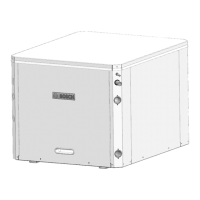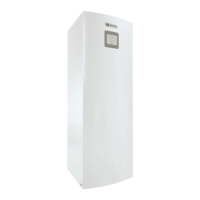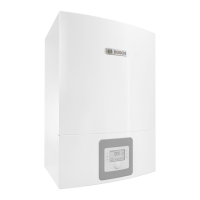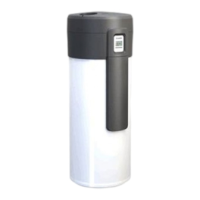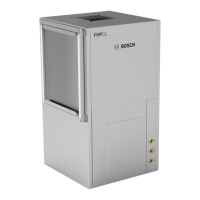Warnings
69
CS3000 AWP – 6721852570 (2023/04)
13 Warnings
13.1 Residual risks
In this section the most common risk situations are indicated as these
cannot be controlled by the manufacturer and could be a source of
danger for people or things.
General risks
Smell of burning, smoke or other signals of serious anomalies may
indicate a situation which could cause damage to people, things or the
unit itself.
Electrically isolate the unit (yellow-red isolator). Contact the authorised
service centre to identify and resolve the problem at the source of the
anomaly.
Accidental contact with exchange batteries, compressors, air delivery
tubes or other components may cause injuries and/or burns.
Always wear suitable clothing including protective gloves to work inside
the danger zone.
Maintenance and repair operations carried out by non-qualified
personnel may cause damage to persons, things or the unit itself.
Always contact the qualified assistance centre.
Failing to close the unit panels or failure to check the correct tightening
of all of the panelling fixing screws may cause damage to persons, things
or the unit itself.
Periodically check that all of the panels are correctly closed and fixed.
If there is a fire the temperature of the refrigerant could reach values that
increase the pressure beyond the safety valve with the consequent
possible refrigerant eject or explosion of the circuit parts that remain
isolated by the closure of the tap.
Do not remain in the vicinity of the safety valve and never leave the
refrigerant system taps closed.
Danger zone
This is an area in which only an authorised operator may work.The
danger zone is the area inside the unit which is accessible only with the
deliberate removal of protections or parts thereof.
Handling
The handling operations, if implemented without all of the protection
necessary and without due caution, may cause the drop or the tipping of
the unit with the consequent damage, even serious, to persons, things or
the unit itself.
Handle the unit following the instructions provided in the present manual
regarding the packaging and in compliance with the local regulations in
force.
Should the refrigerant leak please refer to the refrigerant “Safety sheet”.
Installation
The incorrect installation of the unit could cause water leaks, condensate
accumulation, leaking of the refrigerant, electric shock, poor operation
or damage to the unit itself.
Check that the installation has been implemented by qualified technical
personnel only and that the instructions contained in the present manual
and the local regulations in force have been adhered to.
The installation of the unit in a place where even infrequent leaks of
inflammable gas and the accumulation of this gas in the area surrounding
the area occur could cause explosions or fires.
Carefully check the positioning of the unit.
The installation of the unit in a place unsuited to support its weight and/
or guarantee adequate anchorage may result in consequent damage to
things, people or the unit itself.
Carefully check the positioning and the anchoring of the unit.
Easy access to the unit by children, unauthorised persons or animals
may be the source of accidents, some serious.
Install the unit in areas which are only accessible to authorised person
and/or provide protection against intrusion into the danger zone.
Electric parts
An incomplete attachment line to the electric network or with incorrectly
sized cables and/or unsuitable protective devices can cause electric
shocks, intoxication, damage to the unit or fires.
Carry out all of the work on the electric system referring to the electric
layout and the present manual ensuring the use of a system thereto
dedicated.
An incorrect fixing of the electric components cover lead to the entry of
dust, water etc., inside and may consequently electric shocks, damage
to the unit or fires.
Always fix the unit cover properly.
When the metallic mass of the unit is under voltage and is not correctly
connected to the earthing system it may be as source of electric shock
and electrocution.
Always pay particular attention to the implementation of the earthing
system connections.
Contact with parts under voltage accessible inside the unit after the
removal of the guards can cause electric shocks, burns and
electrocution.
Open and padlock the general isolator prior to removing the guards and
signal work in progress with the appropriate sign.
Contact with parts that could be under voltage due to the start up of the
unit may cause electric shocks, burns and electrocution.
When voltage is necessary for the circuit open the isolator on the
attachment line of the unit itself, padlock it and display the appropriate
warning sign.
Moving parts
Contact with the transmissions or with the fan aspiration can cause
injuries.
Prior to entering the inside of the unit open the isolator situated on the
connection line of the unit itself, padlock and display the appropriate
warning sign.
Contact with the fans can cause injury.
Prior to removing the protective grill or the fans, open the isolator on the
attachment line of the unit itself, padlock it and display the appropriate
warning sign.
Refrigerant
The intervention of the safety valve and the consequent eject of the gas
refrigerant may cause injuries and intoxication.
Should the refrigerant leak please refer to the refrigerant “Safety sheet”.
Contact between open flames or heat sources with the refrigerant or the
heating of the gas circuit under pressure (e.g. during welding
operations) may cause explosions or fires.
Do not place any heat and ignition source next to the refrigerant.
The maintenance or repair interventions which include welding must be
carried out with the system off.
Hydraulic parts
Defects in tubing, the attachments or the removal parts may cause a leak
or water projection with the consequent damages to people, things or
short-circuit the unit.
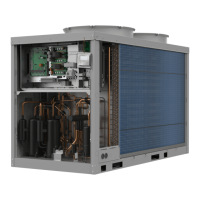
